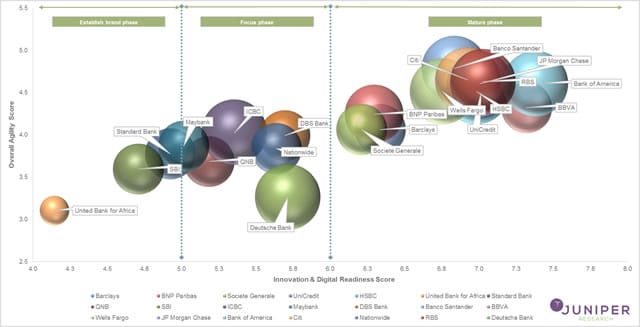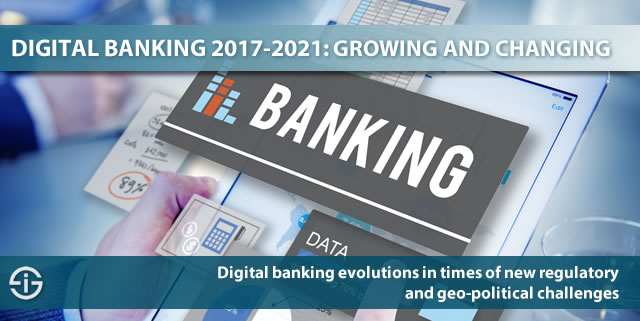Mobile and digital banking remains high on the agenda of retail banks as automation continues to increase and specific, often lower-value, processes and activities are being taken over by various digital challengers such as specific FinTech companies and non-financial firms.
A typical (but far from only) example concerns payments. Yet, while payments might be less lucrative for banks, the experiences and services offered by challengers are a potential game changer in trust, loyalty and more.
Since many years now mobile and digital banking have been on the wish list of both bank customers and of retail banks themselves as they try to move towards where the value and difference is really made in digital transformation initiatives, which in turn are at least partially a reaction on changing consumer attitudes (when was the last time you entered a bank branch and for which reason?).
The open, secure digital banking ecosystem push
Yet while banks continue to see digital (including digitization and digitalization) as being core for growth and innovation (even if de facto initiatives often remain fragmented and ad hoc), other forces and challenges are moving up in the pretty big list of retail bank priorities: anti-globalization and regulatory challenges. And it’s not different for FinTechs.
Increased protectionism and anti-globalization forces obviously have a clear impact on banking. The clearest example is Brexit and all the uncertainties that come along with it. Yet, while Brexit, increasing security woes and multiple compliance challenges, from the EU’s GDPR (General Data Protection Regulation) which aims to enhance personal data protection across the EU, the new ePrivacy Regulation and the Fourth Anti-Money Laundering Directive to PSD2 and many other initiatives across the globe, have joined the various challenges which retail banks face, they need to continue with their digitization and digital transformation efforts.
Various of the mentioned regulatory challenges, despite the uncertainties and difficulties they bring along, in fact aim to create a digital banking environment and an overall retail bank and FinTech/disrupter playfield which enables innovation and ongoing digitalization, while at the same time protecting consumers, the various players in the retail banking scene and the development of digital banking as such.
With the number of cyberattacks being highest in financial services there also simply is no other option than to put cybersecurity – and privacy – by design at the center in order to allow the digital banking ecosystem to grow.
Consumers, banks, FinTechs, non-financial players and regulations all push the digital banking efforts
Moreover, what other choices do retail banks have than to leverage data to innovate, enhance digital customer experience (with PSD2 and FinTech in mind) and meet increasing digital banking demands overall?
Even if there is uncertainty about the steps which will be taken in some countries with regards to financial services for a digital age and with regards to streamlining digital banking initiatives and regulations overall, there is one factor that never can be underestimated: king customer.
And king customer clearly wants digital and mobile banking too. According to Juniper Research, by 2021 almost 3 billion users will access retail banking services by their many digital and mobile devices such as good old PCs, smartphones, tablets, notebooks, smartwatches, you name it.
That’s a growth of 53 percent in comparison with 2017 in a retail banking market where mobile/digital access, depending on region, is already very high. To put the number in perspective: by 2021 about one in two of the global adult population is expected to use digital banking.
Three drivers of digital banking
The factors that contribute to this growth remain pretty much the same as in past years but the drivers, challenges and forces evolve.
1. First, there is indeed king customer. Juniper Research, like many others, sees a growing choice by consumers for the convenience of fast and multi-channel digital services. The obvious consequence for retail banks: make the digital experience frictionless (and don’t settle for those ad hoc or isolated efforts which still are present far too much, you do need a digital banking and digital transformation strategy).
2. Secondly, banks do continue to invest in digital themselves, which as mentioned is obviously partially related with the wants of those mobile and digital banking consumers. According to Nitin Bhas, who wrote the Juniper Research report, investments in banking technology reached record levels in 2016 and ‘traditional’ banks are poised to focus more on their digital transformation initiatives in 2017 (and beyond). Technology is the big differentiator for all types of banks, Bhas continues.
3. Thirdly, there is the FinTech aspect. As we predicted previously, Juniper Research also states that in 2017 large banks will move to acquire challengers across the broad spectrum of newcomers, ranging from start-ups in several banking areas to digital-only banks and non-financial disrupters. The impact of this acquisition wave will accelerate the deployment of digital strategies by traditional banks and digital banking overall.
The true mobile and digital banking ecosystem evolution hasn’t even started yet: the changes ahead
In the press release on its “Retail Banking: Digital Transformation & Disruptor Opportunities 2017-2021” report, Juniper states that “while traditional banks have so far remained a step behind in delivering innovation and maintaining their competitive edge against new fintech players, the situation is gradually changing”.
Yet, there is more. Traditionally we’ve been making this difference between the strengths of FinTech players and retail banks whereby ‘traditional’ retail banks have the benefit of the cash (most, at least), the customers and the regulatory know-how as we wrote earlier (with the exception of some FinTech players and that specific FinTech segment, RegTech). FinTechs, on the other hand are said to have the agility, technological know-how and user experience understanding.
Although in general this is true, it’s not a black and white picture. Several FinTechs have user experience issues as well and several incumbents certainly dispose of the agility and know-how to launch their own initiatives, as some did.
While, in general, it seems that banks have completely changed their attitudes toward FinTech, with an ongoing different stance in Europe where, just as in 2016, banks predominantly keep looking at FinTech as a challenge, the impact of the various regulatory and geopolitical evolutions, of which we mentioned a few also highly impact the retail bank transformation and retail bank and FinTech relation.
For example: FinTechs serving EU customers will have to follow the same rules as banks with regards to the GDPR to avoid GDPR fines and penalties. And at least as important: the ‘open banking’ movements across the globe with the new EU Payments Services Directive or PSD2, which brings in open APIs and data interchange, in the overall banking ecosystem (as of January 2018) also plays a key role in the changing ecosystem of the ‘traditional’ bank, FinTech and most of all non-financial companies who offer financial services.
While a lot has been said about the benefits, risks (more risks from a security perspective indeed), impacts (retail banks focusing even more on digital customer experience) and fairness of these new rules (which are being streamlined and revised as there is too much confusion with all the overlaps), one thing is for sure: the mobile and digital banking evolution is far from ready and the most challenging and interesting is yet to come.

Top image: Shutterstock – Copyright: Rawpixel.com – All other images are the property of their respective mentioned owners.


